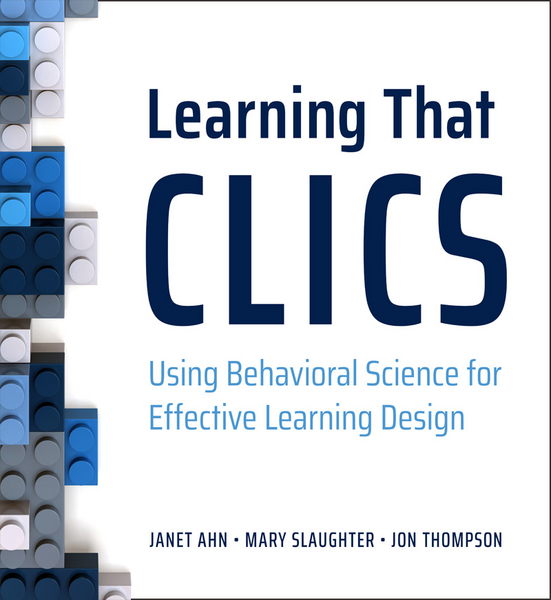ATD Blog
Using Behavioral Science to Improve Learning Solutions
Tue May 24 2022

Bookmark
Learning That CLICS: Using Behavioral Science for Effective Design introduces the CLICS framework, a concise, practical way to apply brain science and a human-centric approach to the art of learning design. Created by learning practitioners for learning practitioners, the CLICS framework is a five-step approach that deepens analysis and increases the likelihood that learning will occur. Janet Ahn, Jon Thompson, and Mary Slaughter, authors of Learning That CLICS, share some insights about the book and its model below.
What prompted you to write this book?
Mary Slaughter: From a content perspective, each of us has encountered countless scenarios where the need for training had been identified as the solution, but the actual learning experience has gone wrong due to weak analysis and poor planning. These are but a few examples of common problems organizations struggle with:
“Our people don’t understand our new processes or what they need to do differently. Can’t we pull some training together quickly?”
“We need a new onboarding program that will make new hires proficient at their jobs in 30 days.”
“If we don’t train people as soon as possible, we’re not going to hit our sales targets. We need to start training now!”
We’d seen these patterns repeat themselves and knew many of our experiences reflected a disconnect between the daily practices at work and how humans learn. Our goal was to demystify the essential science and infuse it into a framework that was easy for practitioners to apply.
From a timing perspective, sometimes life presents us with opportunities too big to ignore. We had been developing the ideas and framework for several years but had told ourselves we were too busy to make the book happen. When the pandemic hit, we found ourselves with an abundance of time. Writing helped us purposefully stay connected and to some extent was even therapeutic. We genuinely looked forward to our three-hour working sessions every weekend.
What is CLICS? How and why were these five domains added?
Jon Thompson: CLICS is a framework we have created to guide your thinking, questioning, and assessment of a situation that may (or may not) require a learning solution. CLICS itself is an acronym that represents the five domains of the framework of considerations geared at helping create effective long-term learning:
Capacity: the amount of information we can process at a given time
Layering: the timing and sequencing of learning in an organized way
Intrinsic enablers: internal reasons that influence the learner’s motivation to care
Coherence: the cognitive ease with which information fits together and amplifies related ideas
Social connections: the interpersonal support structure (be that physical, emotional, and psychological) necessary to learn optimally and to be effective
We identified these five domains as those with the greatest impact on the likelihood of driving effective learning transfer among learners while also accounting for the environment or ecosystem a learning solution gets deployed into. Both sides of these considerations are necessary when deciding the “contents” and makeup of a potential learning solution. Without accounting for each of these things, one runs the risk of missing factors that lead to less desirable outcomes and don’t achieve desired results.
Additionally, the acronym is itself intended to represent the idea that when these five domains are taken into consideration in the design of a learning solution, they lead to that concept, or concepts, clicking into place for the audience or learner.
Are the domains discrete? How can someone apply the framework?
Janet Ahn: While we view these domains as more effective when viewed as a whole, we place priority on Capacity and Coherence. Capacity is the starting point because it gives the learner the best shot at absorbing information. Too much information placed on the learner can easily deplete the learner and prevent them from making optimal use of their resources and processing the new material. Capacity gets to what matters most. Coherence helps align the strategy and vision down to specific initiatives so there aren’t conflicting or competing priorities. This allows learners to “fit” the information in a meaningful way so it can stick.
In terms of applying the framework, we provide a tool for asking the right questions within each of the domains. This enables you to frame the discovery process as a set of considerations within each domain. We focus on the solution by helping you determine the factors that may impact the learner while also taking into account the environment or ecosystem the solution will be deployed into. As we mention in the book, learning doesn’t occur in a vacuum but rather in our already packed day-to-day lives.
How does CLICS fit with ADDIE or SAM?
Jon Thompson: ADDIE and SAM are two different approaches to how a learning solution comes into being for a defined learner audience. Neither inherently addresses what needs to be in a particular solution in and of itself. CLICS, as a design pattern based in behavioral science, fits within the broader approach of not just ADDIE and SAM but also within any other instructional systems model for that matter. It does this by helping ascertain exactly the point and purpose of the solution by specifically getting to what is necessary for the identified learner based on the environment into which the solution will be deployed.
CLICS focuses on the requirements of the stakeholder, filtered by what the prospective audience/learner requires and managed by the ecosystem in which the solution will exist. CLICS helps create continuous learning solutions by taking a complete picture of considerations into account, regardless of the ISD approach you or your organization choose to employ.
Why should we consider behavioral science as the answer to learning challenges?
Janet Ahn: Relying on human intuition and experience is helpful, but it’s flawed because of the different biases we naturally have. If we make decisions about how to approach learning solely based on our gut feeling and intuition, we will miss the mark on what is truly needed. Additionally, our experience and intuition incline us to favor a certain approach to learning, “We’ve done this in the past and it worked.” But context shifts so often that, sometimes, applying the same methodology is not useful in a different place and time. Behavioral science offers us the ability to rely on empirical data that will get us closer to the “source of truth” and adapt and flex when needed.
Who would benefit from using CLICS?
Mary Slaughter: Learning practitioners certainly will benefit from the book, as our approach is pragmatic and application-focused. Traditional roles such as instructional designers and developers, as well as learning solutions consultants, would be able to use these concepts immediately.
Also, HR business partners or internal talent consultants would find these concepts useful in guiding business leaders as they develop their roadmaps of desired initiatives. Even project management professionals can apply these concepts to change initiatives that require behavior change at scale. We’re hoping our framework will enable business leaders to appreciate how to successfully plan and integrate learning initiatives, so they achieve the business results they desire.
About the Authors
Dr. Janet Ahn is an experimental social psychologist preparing some of the world’s biggest organizations for the challenges of tomorrow and believes in the power of behavioral science to transform lives and companies. As a global organizational leader, she leads product innovation, research and development, and digital solutions.
Mary Slaughter is a seasoned corporate executive, human capital consultant, and published author whose global enterprise roles have included chief learning officer, chief talent officer, global head of employee experience, chief diversity and inclusion officer, and chief human resources officer.
Jon Thompson has spent more than 25 years serving clients, stakeholders, and learners in the talent development space. He serves as director of learning experience and innovation at the Coca-Cola Company.
About ATD and ATD Press
The Association for Talent Development (ATD) is the world’s largest association dedicated to those who develop talent in organizations. ATD’s members come from more than 120 countries and work in public and private organizations in every industry sector. ATD Press publications are written by industry thought leaders and offer anyone who works with adult learners the best practices, academic theory, and guidance necessary to move the profession forward. For more information, visit td.org/books.

Learning That CLICS: Using Behavioral Science for Effective Learning Design
ISBN: 9781953946324 | 168 Pages | Paperback
td.org/book/learning-that-clics
To order books from ATD Press, call 800.628.2783.
To schedule an interview with the authors, please contact Kay Hechler, ATD Press senior marketing manager, at khechler@td.org or 703.683.8178.
More from ATD

